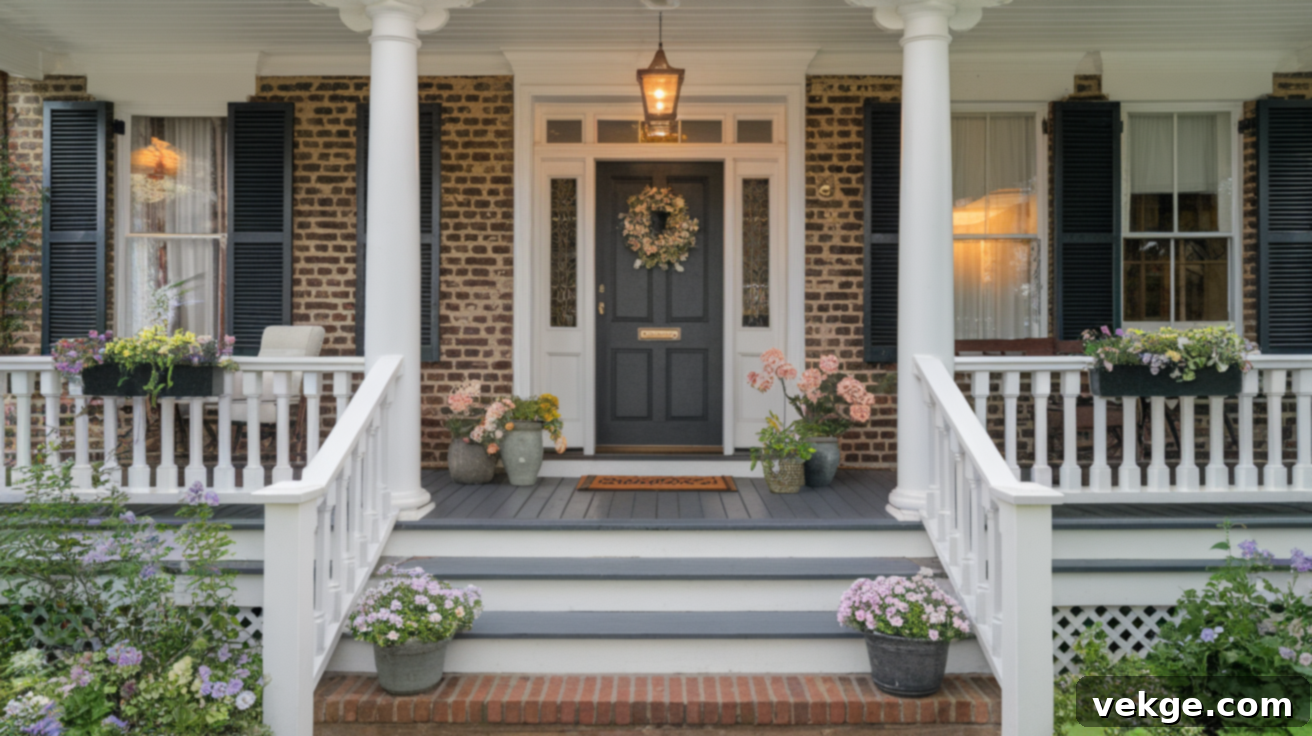Elevate Your Home’s Curb Appeal: The Ultimate Guide to Inspiring Brick Front Porch Ideas, Design & Maintenance
Your home’s front porch is more than just an entryway; it’s a powerful statement of welcome and a reflection of your personal style. It’s the very first impression visitors have, setting the tone for the warmth and character that lies within. Among the myriad of material choices, a brick front porch stands out as a timeless classic, offering a unique blend of exceptional durability, inviting warmth, and undeniable character that instantly elevates your home’s exterior.
Unlike other materials that may quickly show signs of wear and tear, brick maintains its inherent beauty and structural integrity for decades, often with surprisingly minimal upkeep. Its robust nature makes it an ideal choice for a high-traffic area, ensuring your entrance remains welcoming and beautiful through countless seasons and footfalls.
This comprehensive guide delves into a diverse range of inspiring brick front porch ideas, spanning from cherished classic designs to sleek modern aesthetics. Whether your home is a traditional colonial, a rustic farmhouse, or a contemporary marvel, you’ll discover options that harmoniously blend with various architectural styles, fit within different budgets, and cater to a wide array of personal tastes. Whether you’re embarking on a complete porch rebuild or simply looking to refresh your existing space, these ideas and practical tips will empower you to create a front porch that is not only highly functional and practical but also profoundly appealing and truly inviting. Are you ready to transform your home’s entrance into its most charming and welcoming feature?
The Enduring Appeal and Core Benefits of a Brick Front Porch
Choosing brick for your front porch is an investment in both beauty and longevity. Here’s why brick continues to be a top choice for homeowners:
- Unmatched Durability: Brick is renowned for its incredible strength and resilience. It can withstand harsh weather conditions, heavy foot traffic, and the test of time, resisting rot, pests, and fire far better than many other materials. This means fewer repairs and a longer lifespan for your porch.
- Timeless Aesthetic and Warmth: The natural hues and textures of brick lend an inherent warmth and classic elegance to any home. From deep reds and earthy browns to more contemporary grays, brick offers a versatile palette that complements a vast array of architectural styles, creating a welcoming and established look.
- Increased Home Value and Curb Appeal: A well-designed brick front porch significantly enhances your home’s curb appeal, making it more attractive to potential buyers should you ever decide to sell. It adds architectural interest and suggests quality construction, contributing positively to your property’s overall market value.
- Low Maintenance Requirements: Once properly installed, brick porches require remarkably little maintenance. Regular sweeping and occasional cleaning are typically all that’s needed to keep them looking pristine, freeing up your time for other activities rather than constant upkeep.
- Versatility in Design: Despite its traditional roots, brick is incredibly versatile. It can be laid in numerous patterns, combined with other materials like wood or wrought iron, and even painted to achieve a desired aesthetic, allowing for endless customization to match your home’s unique character.
Essential Considerations Before Designing Your Dream Brick Front Porch
Before you dive into the exciting world of brick porch designs, a thoughtful planning phase is crucial. Addressing these key considerations will ensure your new front porch is both beautiful and perfectly suited to your home and lifestyle.
1. Matching Brick Style and Type to Your Home’s Architecture
The type and color of brick you choose are paramount to achieving a cohesive look. Consider your home’s existing color scheme, architectural style, and the surrounding landscape.
- Classic Red Brick: Offers a traditional, timeless feel that pairs beautifully with Colonial, Georgian, and many traditional American homes. It exudes warmth and familiarity.
- Painted Brick: Can dramatically brighten your home’s entrance, providing a fresh, updated look. This is an excellent option for modernizing older homes without a full brick replacement. White painted brick, for instance, offers a crisp, contemporary contrast to vibrant landscaping.
- Thin Brick (Brick Veneer): Provides the authentic look and feel of traditional brick but with easier installation, as it’s lighter and requires less structural support. This makes it ideal for updating existing porches or for homes where full brick is not feasible. It’s often favored in more modern or minimalist designs.
- Reclaimed or Weathered Brick: Perfect for rustic or farmhouse styles, these bricks offer a sense of history and unique character with their slightly uneven textures and varied color tones.
- Mortar Color: Don’t overlook the mortar! It plays a significant role in the overall appearance. White mortar can create a striking contrast, emphasizing each brick, while gray or tan mortar can blend in for a more subdued, monolithic look.
2. Durability and Climate Suitability
Your porch needs to withstand the elements of your local climate. Select bricks designed for your region’s weather conditions:
- Water Absorption: In areas with heavy rainfall or frequent freeze-thaw cycles, choose bricks with low water absorption rates to prevent cracking and deterioration.
- Slip Resistance: Ensure the brick surface will not become excessively slippery when wet. Textured bricks or specific sealers can enhance safety.
- Structural Integrity: Work with a professional to ensure your foundation is adequate for the weight of brick, preventing future settling or cracking. Quality mortar and proper installation are key to a long-lasting porch.
3. Budget and Scope of Project
Your budget will largely dictate the scale of your project. Are you planning a complete rebuild, or a simpler aesthetic update?
- Full Rebuild: This involves tearing out the old structure and building anew. It offers the most design flexibility but is also the most expensive and time-consuming.
- Resurfacing/Veneer: Applying thin brick veneer over an existing stable concrete porch can be a more budget-friendly way to achieve the brick look.
- Material Costs: Consider the cost of the brick itself, mortar, foundation materials, and any additional features like railings or lighting.
- Labor Costs: Professional installation ensures quality but adds to the budget. If you’re a DIY enthusiast, calculate the time and tools required.
4. Layout, Size, and Functionality
The layout and dimensions of your porch should align with how you intend to use the space, ensuring comfortable flow and practical functionality.
- Traffic Flow: Measure the available area and map out clear pathways to your front door. Ensure there’s ample room for people to move without feeling cramped.
- Seating Areas: If you envision a sitting area, allow at least 6-8 feet of depth for comfortable furniture placement and easy movement around it. Position furniture to create inviting conversation areas that don’t obstruct main pathways.
- Steps and Railings: Design steps to be wide enough (at least 4 feet is recommended for main entrances) and include proper railings for safety, especially if there are more than three risers.
- Views and Natural Light: Consider how the porch will look from both inside and outside your home. Ensure the design allows for ample natural light into your home and preserves any desirable views.
- Architectural Harmony: The size and proportion of the porch should complement the overall scale of your house. A porch that’s too large or too small can look out of place.
5. Local Regulations and Permits
Before any construction begins, check with your local municipality for any necessary building permits or zoning restrictions. This ensures your project complies with all local codes and avoids potential legal issues.
Inspiring Brick Front Porch Ideas to Elevate Your Home’s Curb Appeal
A thoughtfully designed brick front porch not only adds classic style and significant value to your home but also crafts an undeniably warm and welcoming entrance for every guest. Explore these inspiring ideas to envision the perfect brick porch for your unique home:
1. Classic Red Brick with White Railings
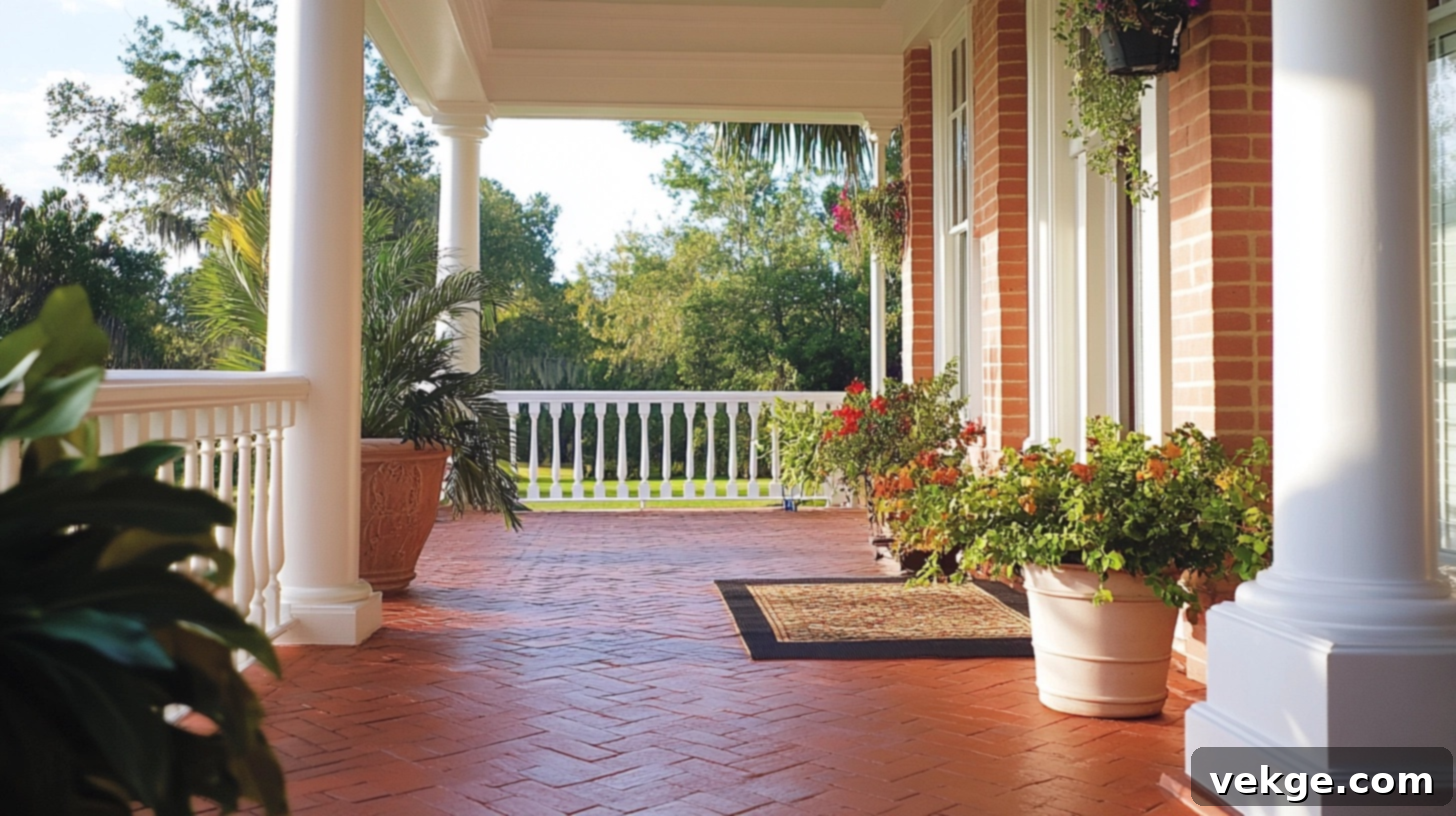
This iconic pairing combines the rich, warm tones of traditional red brick with the crisp, clean lines of white railings. It’s a design that effortlessly evokes a sense of timeless elegance and works exceptionally well with Colonial, traditional, and Cape Cod-style homes. The stark contrast between the deep red and brilliant white creates striking visual appeal, making your porch a focal point while maintaining a dignified, formal appearance. Enhance this look with symmetrically placed potted plants and classic lanterns for a truly inviting entrance.
2. Rustic Farmhouse Brick Porch
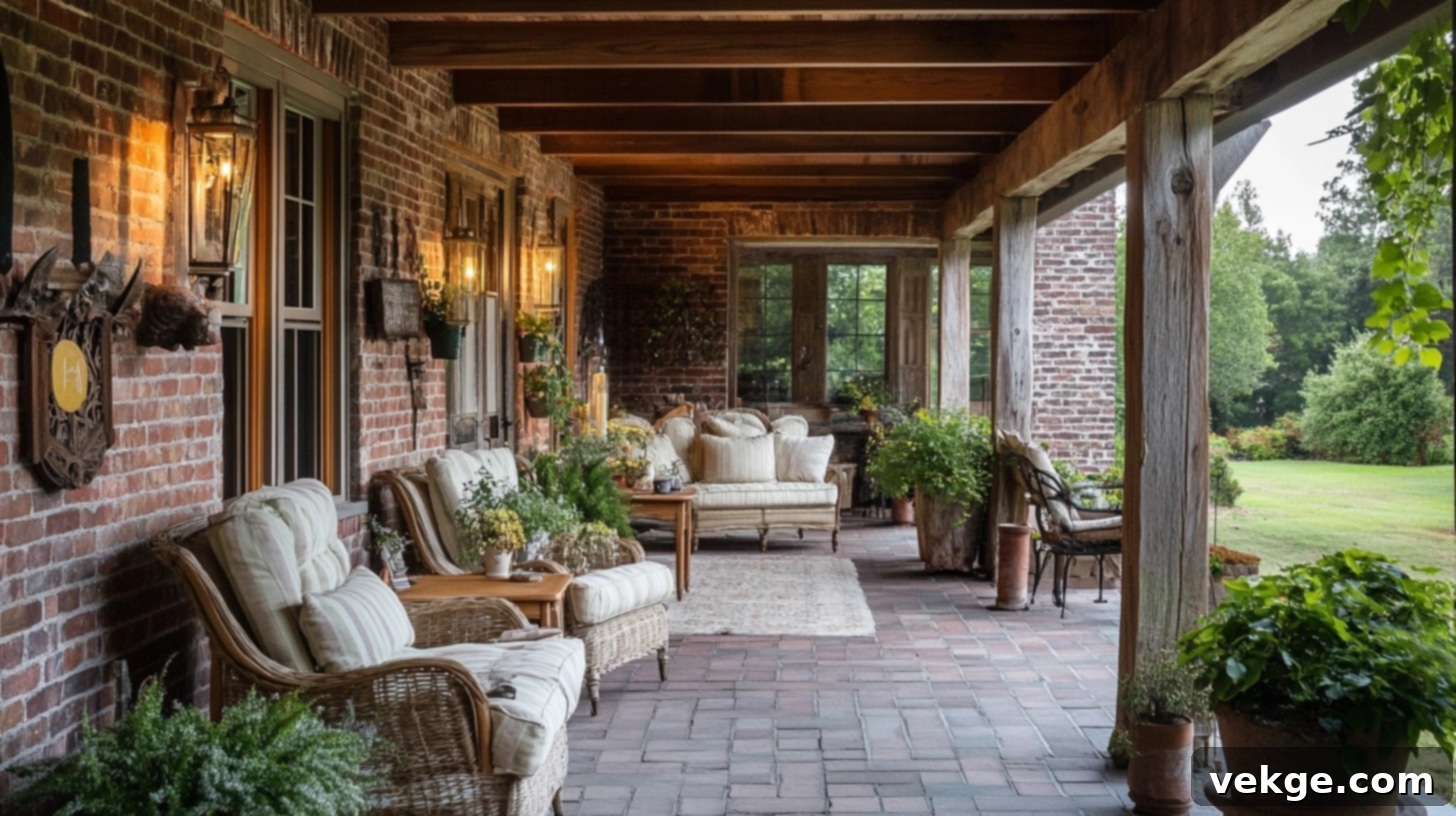
Embrace a warm, lived-in feel by blending natural brick with robust wooden beams, substantial posts, and comfortable outdoor furniture. This style often features reclaimed or weathered brick, whose slightly uneven textures and faded hues add character and a charming sense of history to your home’s entrance. Pair it with a rustic wooden swing, natural fiber rugs, and an abundance of lush potted greenery to complete the cozy farmhouse aesthetic, inviting long, leisurely afternoons.
3. Modern Thin Brick Porch
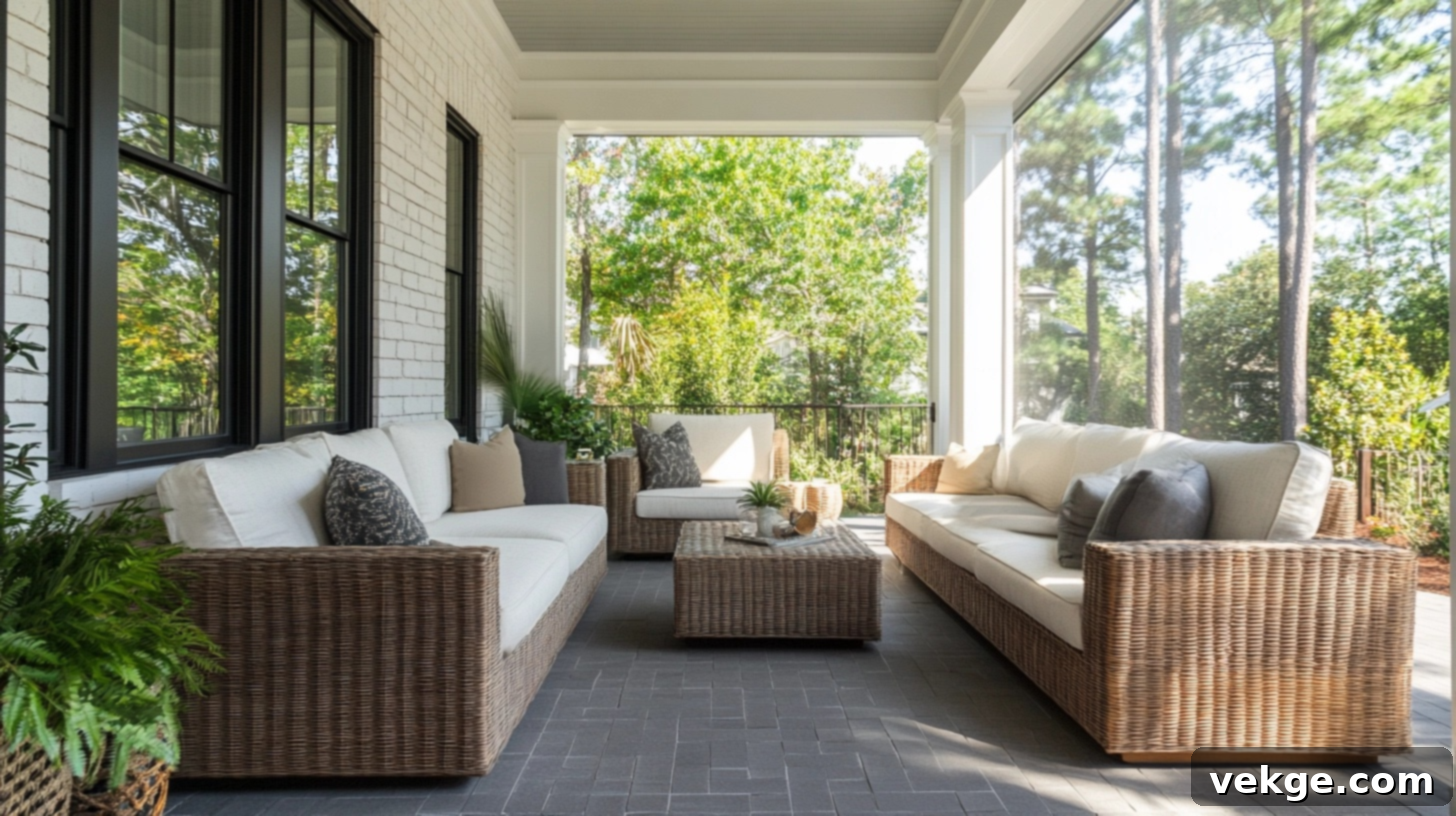
For a sleeker, more contemporary look, a modern thin brick porch utilizes slimmer brick profiles and often monochromatic color schemes. This lighter, more subtle profile integrates seamlessly into modern architectural designs and can be installed more easily than traditional full-depth brick, making it an excellent choice for updating existing concrete porches. Opt for grays, whites, or even darker charcoal bricks laid in a simple stack bond pattern to achieve a minimalist yet sophisticated entrance that complements clean lines and expansive windows.
4. Brick Porch with Wrought Iron Railings
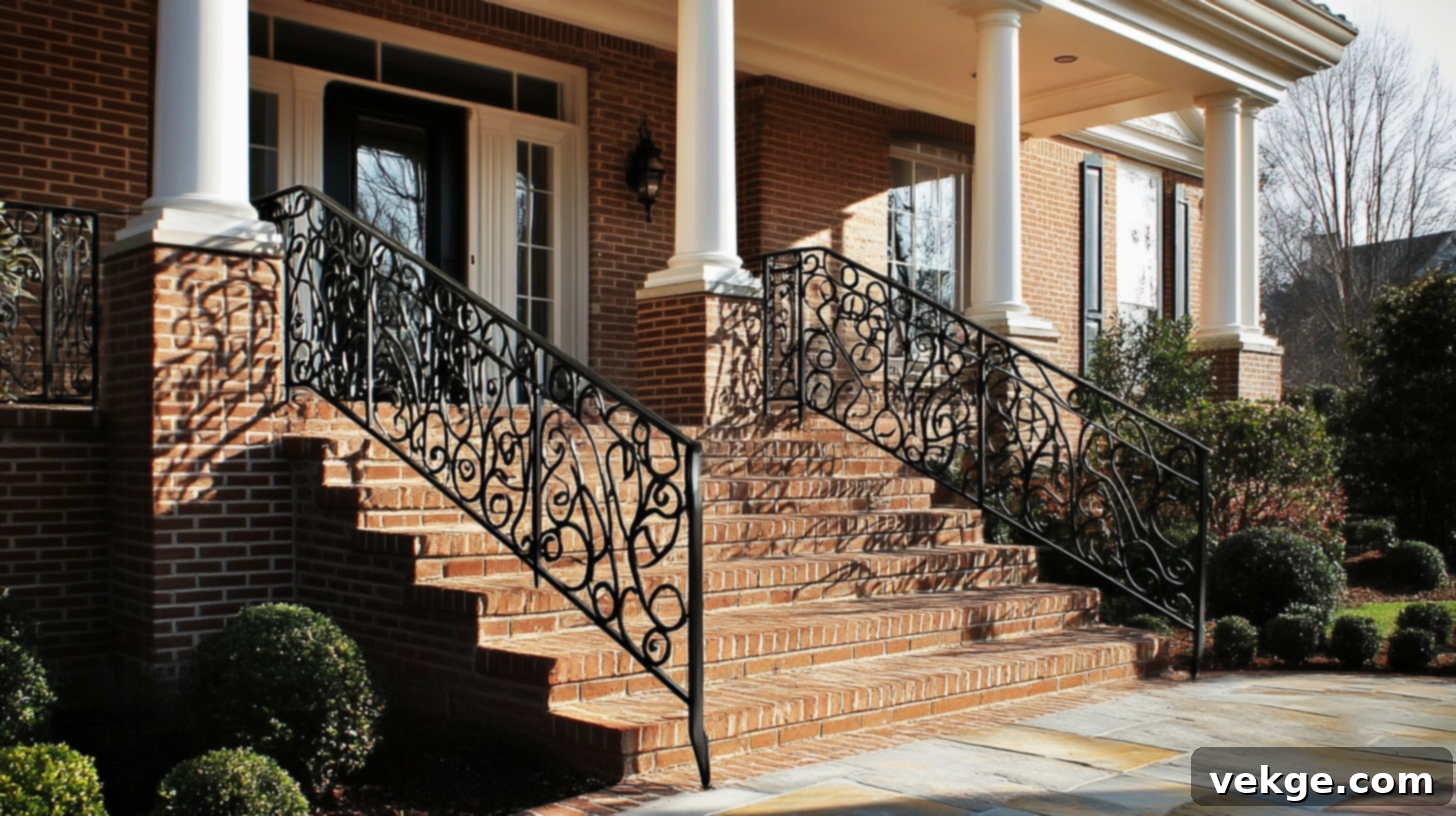
Marrying the enduring warmth of brick with the strength and intricate visual appeal of dark metal railings creates a truly distinguished porch. This combination offers both enhanced safety and significant style. Wrought iron allows for intricate, decorative patterns that can cast beautiful shadows across the brick surfaces, adding depth and elegance. This design is particularly well-suited for historic homes, Victorian residences, or any property where a touch of classic sophistication and robust security is desired. Consider adding matching wrought iron light fixtures for a cohesive look.
5. Brick Porch with Planters and Greenery
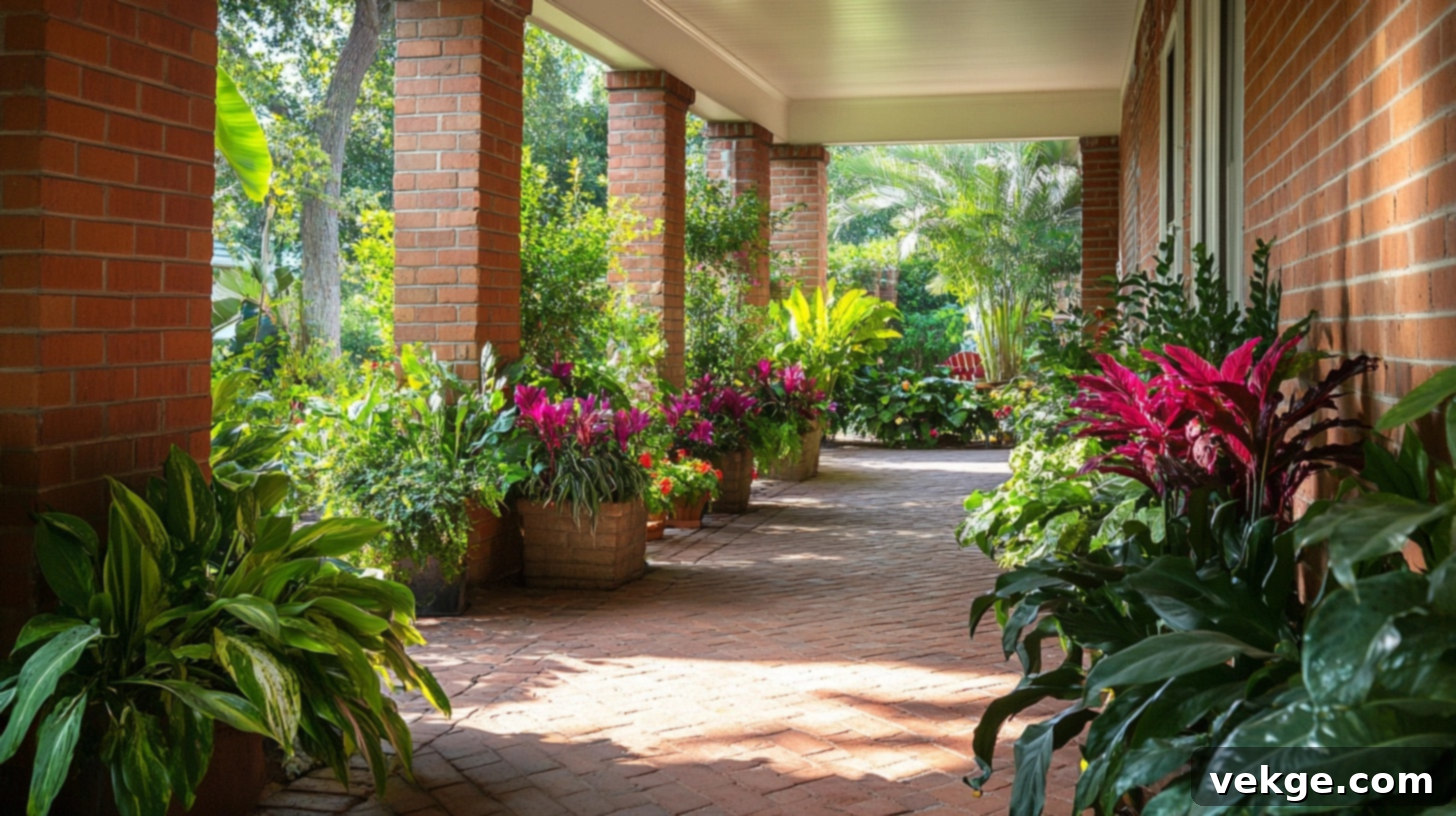
Soften the hard, structured edges of brick by thoughtfully incorporating vibrant plant life. Whether through built-in brick planters that seamlessly extend from your porch’s structure or strategically placed pots brimming with colorful flowers, lush shrubs, or fragrant herbs, greenery adds immediate life, color, and a welcoming organic touch. This idea transforms your porch into a more inviting and visually appealing entrance, connecting your home with its natural surroundings. Seasonal plant rotations can keep the look fresh year-round.
6. Exposed Brick and Concrete Flooring
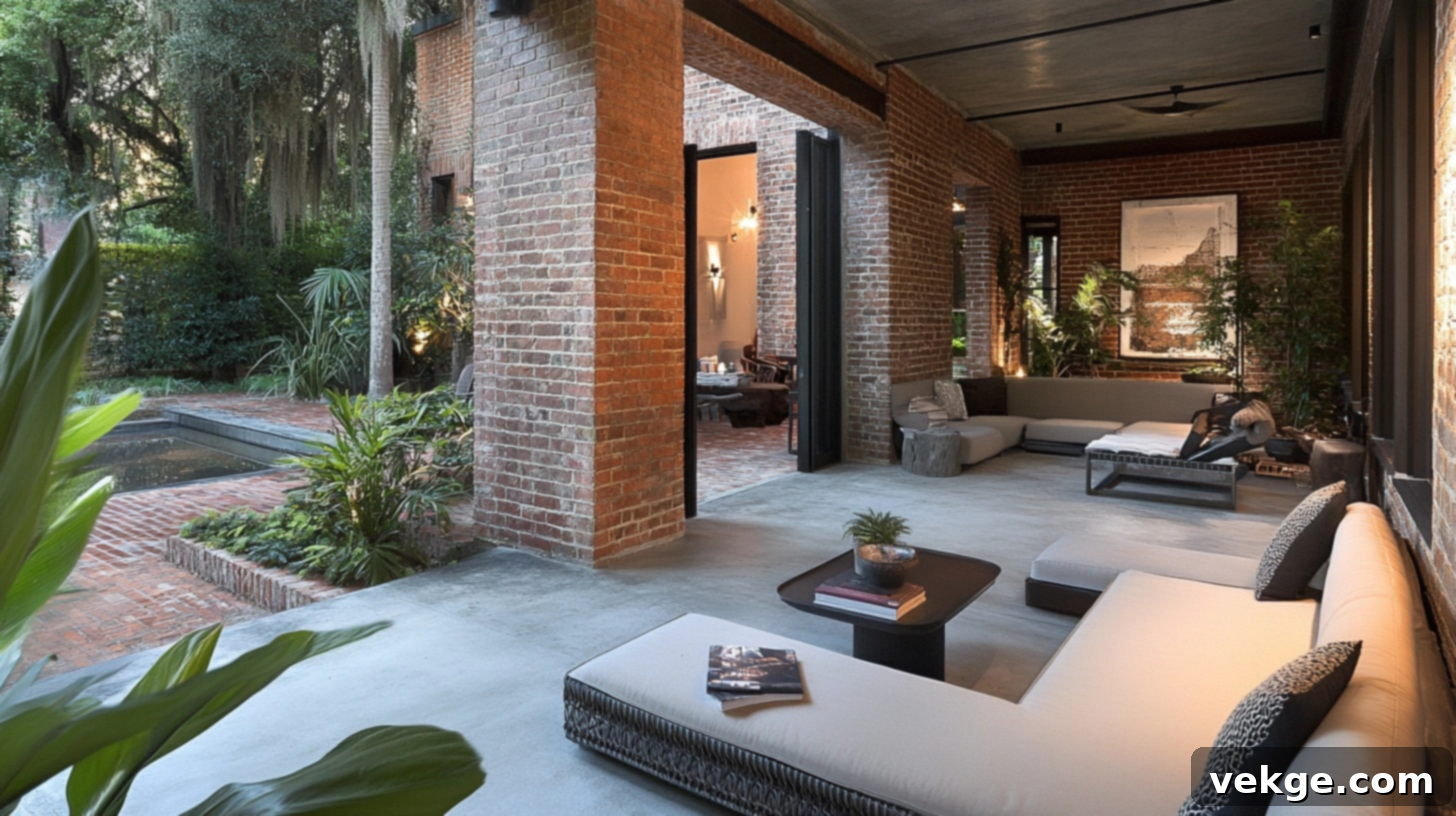
Achieve an urban, loft-like aesthetic by pairing the raw, textured beauty of exposed brick walls with the sleek, smooth finish of concrete floors. This design choice leans into an industrial-chic vibe, offering a remarkably low-maintenance combination that works exceptionally well for homes with modern, minimalist, or industrial design elements. The contrast between the rugged brick and refined concrete creates a sophisticated yet unpretentious space. Consider staining or polishing the concrete for an added layer of finish.
7. Porch Swing with Brick Foundation
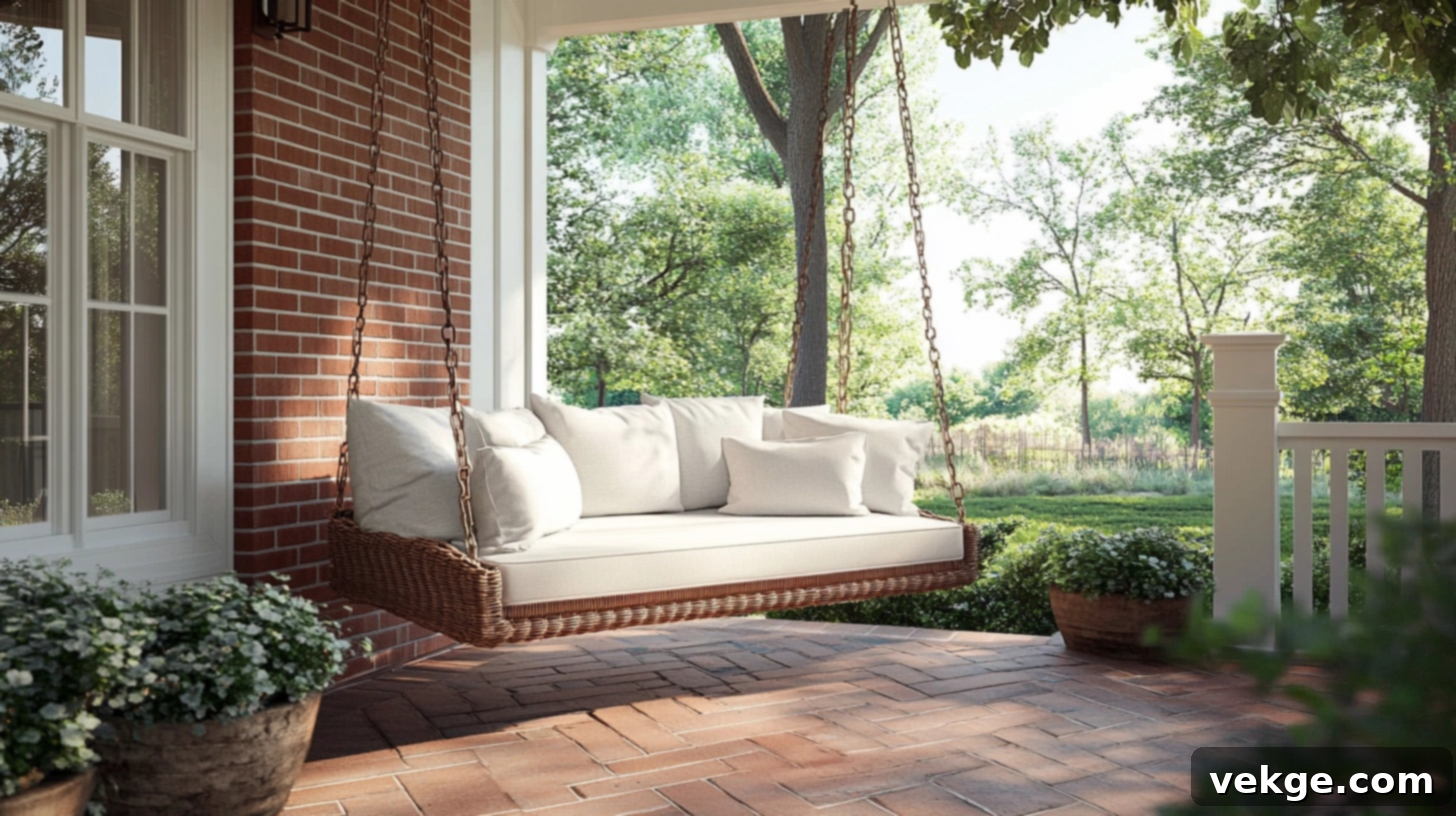
Create an idyllic and cozy spot for relaxation by mounting a comfortable porch swing onto a sturdy brick structure. This classic addition instantly makes your porch more functional, inviting you to unwind, read, or simply enjoy the outdoors, while simultaneously adding a touch of nostalgic charm and Southern hospitality to your home’s entrance. Ensure the brick foundation is robust enough to support the swing’s weight and consider adding plush cushions and throw pillows for ultimate comfort and style.
8. Contemporary Brick and Glass Porch
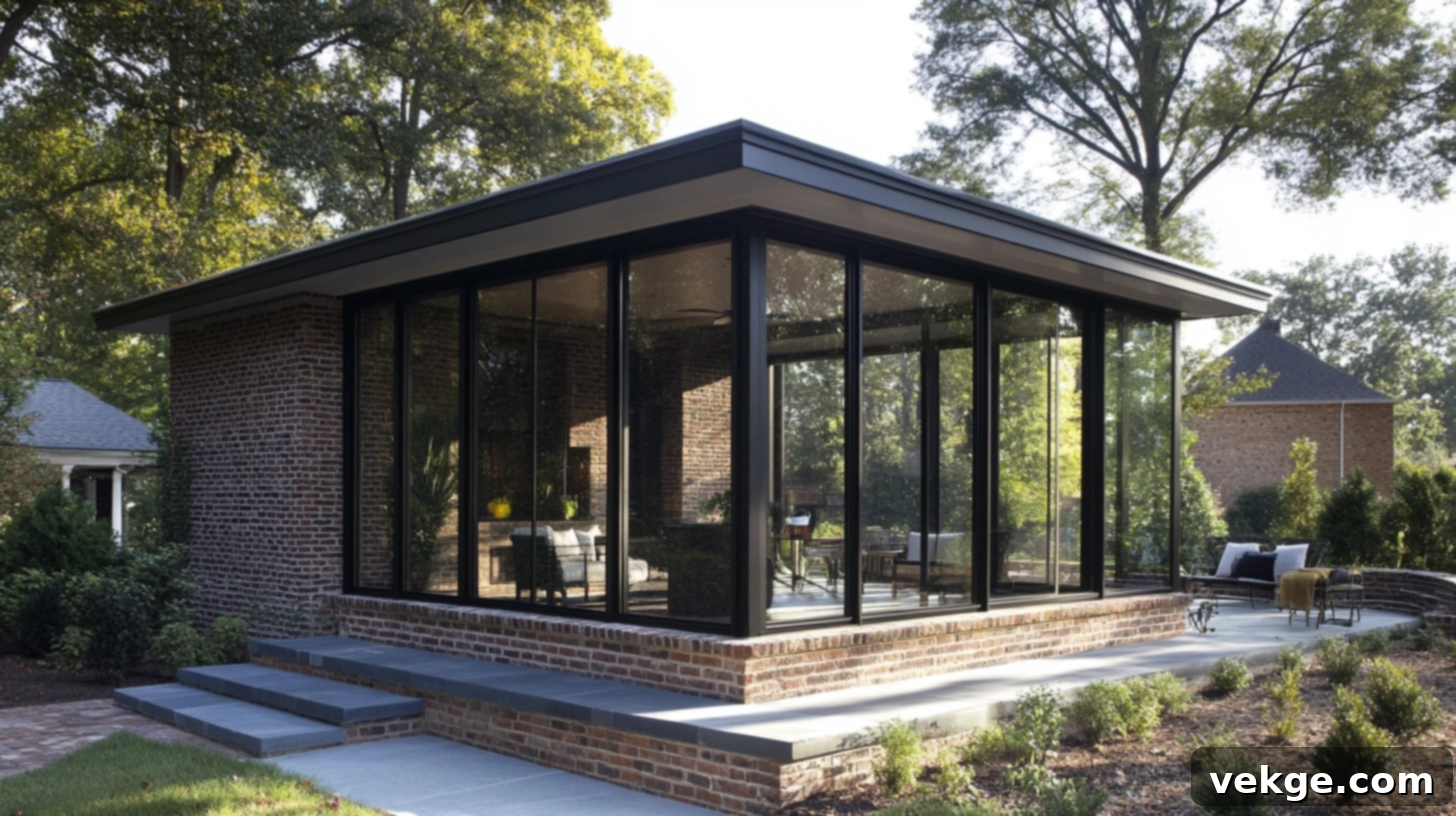
This design masterfully blends the inherent warmth of traditional brick with the sleek transparency of modern glass panels or expansive windows. The result is a bright, open, and airy space that maintains a strong connection with the outdoors while providing essential shelter from the elements. The captivating contrast between the solid, grounded brick structure and the light, transparent glass creates significant visual interest and allows natural light to flood the area, making the porch feel like an extension of your home’s interior. This is ideal for homes seeking a balance of classic and modern.
9. Brick Front Porch with Decorative Tiles
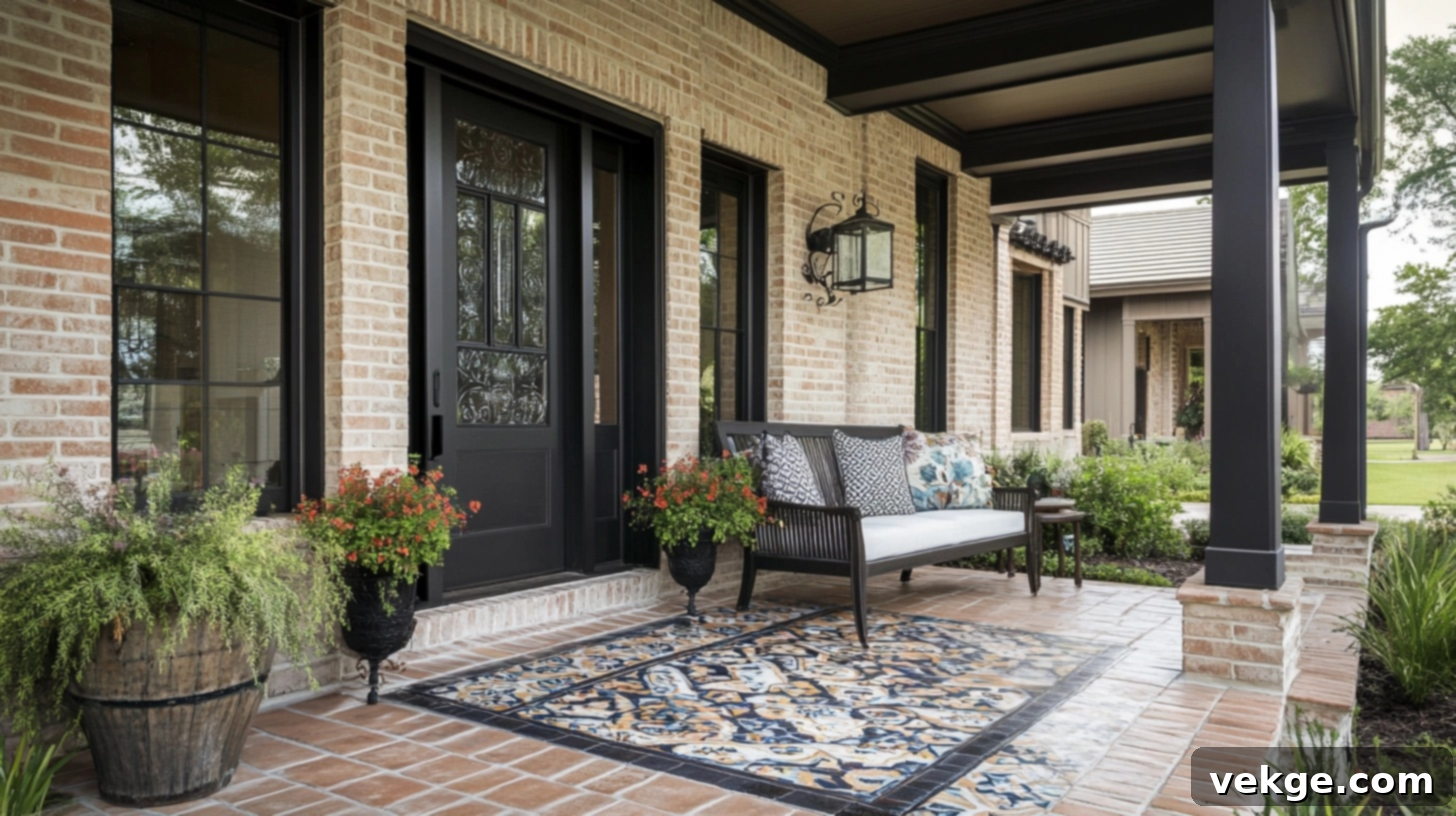
Add an unexpected burst of visual appeal and personality by incorporating patterned or decorative tiles into your brick front porch, either at the threshold, as a central rug-like design, or as accent pieces. These decorative elements create a captivating focal point and can beautifully tie together color schemes from both your home’s exterior and interior. Choose tiles that complement your brick’s tone while introducing a unique pop of color or intricate pattern, reflecting your personal style and potentially adding a cultural or artistic touch to your entrance.
10. Circular Brick Pattern Porch

Transform a standard rectangular entrance into an eye-catching feature through creative and intricate brick placement. Arranging bricks in circular, fan, or herringbone patterns adds a remarkable layer of sophistication and craftsmanship to your home’s entrance. These unique layouts instantly draw attention, create a distinctive welcome area for guests, and speak volumes about the attention to detail in your home’s design. This technique works particularly well on larger porches where the pattern can truly be appreciated.
11. Brick Steps Leading to a Wooden Porch
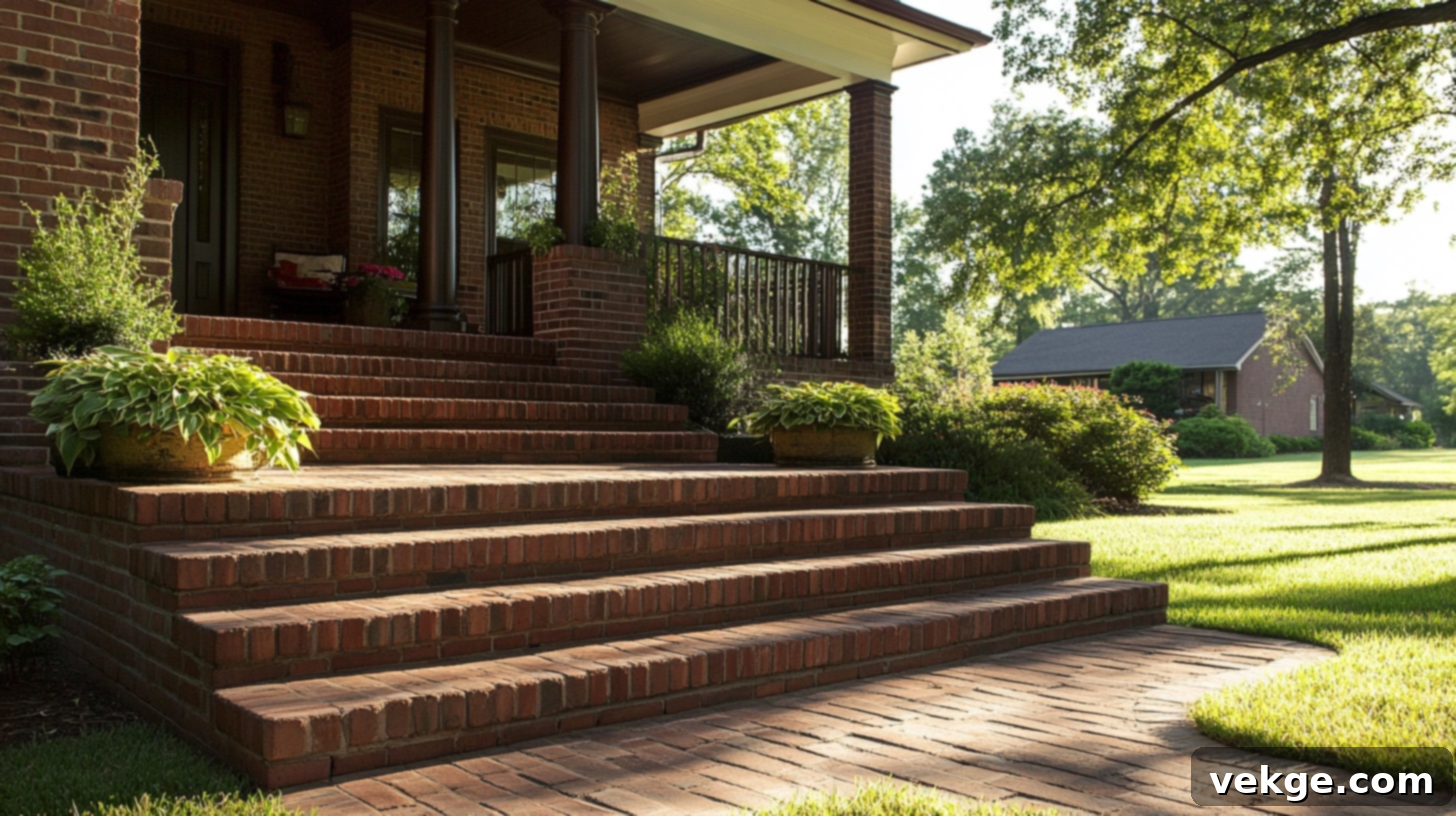
This intelligent design pairs the rugged durability and low maintenance of brick for high-traffic steps with the inherent warmth and softer aesthetic of wood for your main porch floor. This practical combination offers the best of both materials: sturdy, long-lasting brick steps that seamlessly transition to a comfortable, inviting wooden deck area. The wood brings a natural, tactile element that feels more connected to your home’s interior living spaces, creating a harmonious and functional entry point. Regular maintenance for the wooden section will be required.
Step-by-Step Guide: How to Install Your Brick Front Porch
Installing a brick front porch is a significant project that requires careful planning, precision, and diligent work. While homeowners with basic building skills can tackle smaller projects, larger or more complex designs often benefit from the expertise of a professional contractor to ensure structural integrity and a flawless finish.
1. Planning and Preparation
Before any physical work begins, meticulous planning is key. Start by obtaining any necessary permits from your local building department. Gather all required tools (shovels, levels, tape measure, string, stakes, trowels, wheelbarrow, safety gear) and materials (bricks, mortar mix, gravel, sand). Clearly mark the desired porch area using stakes and string, ensuring the dimensions match your design. Plan for proper drainage by identifying the slope away from your house (typically 1/4 inch per foot).
2. Foundation Construction
The foundation is the most critical element for a long-lasting brick porch. Begin by excavating the marked area, removing approximately 6-8 inches of soil to accommodate the base layers. This depth should also account for the frost line in your region to prevent heave. Lay down a weed barrier fabric, then add a layer of crushed gravel (4-6 inches deep) to create a stable, well-draining sub-base. Compact the gravel thoroughly using a plate compactor or hand tamper. Ensure a slight slope (about 1/4 inch per foot) away from your house to direct water runoff effectively. Finally, add a 1-2 inch layer of sand over the gravel, leveling it carefully.
3. Laying the Bricks
With your foundation ready, it’s time to lay the bricks. Decide on your preferred pattern beforehand – common choices include the classic running bond, stack bond, or more intricate herringbone or basket weave patterns. If using mortar, mix it according to the manufacturer’s directions to achieve a consistent, workable consistency. Begin laying bricks from one corner, applying a thin, even layer of mortar (or setting them directly into the sand bed for dry-laid pavers) for each brick. Use spacers to maintain consistent joint widths (typically 3/8 to 1/2 inch) between bricks. Regularly check your work with a long level to ensure the surface remains perfectly flat and slopes correctly. As you go, use a pointing trowel to remove any excess mortar from the brick faces before it has a chance to harden, making cleanup much easier.
4. Finishing and Curing
Once all bricks are laid, allow the mortar to set partially (if used). Then, fill all joints thoroughly with additional mortar or fine polymeric sand, sweeping the material across the surface until all gaps are completely filled. If using sand, lightly spray the porch with water to activate the polymers and help the sand settle firmly between the bricks. For mortared installations, use a jointing tool to create a clean, uniform finish on the mortar lines. Allow your newly installed porch to cure for a minimum of 24-48 hours (or longer, as per mortar instructions) before placing any furniture on it or allowing heavy foot traffic. After the initial curing period, consider applying a high-quality brick-specific sealer. This protective layer will shield your new porch from moisture damage, efflorescence, and staining, ensuring its beauty endures for many years.
Maintaining Your Brick Front Porch for Lasting Beauty
With consistent and proper care, a brick porch can truly last for generations, becoming a treasured feature of your home. Establishing a regular upkeep routine is paramount to preventing common issues like cracking, staining, and loose mortar, which can escalate into more costly and time-consuming repairs down the line.
- Weekly Sweeping: Regularly remove leaves, dirt, and general debris with a stiff broom. This simple step prevents organic matter from breaking down and staining the brick or trapping moisture.
- Bi-Annual Washing: Twice a year, give your brick porch a thorough wash using a mild soap (like dish soap) mixed with water. Use a soft-bristled brush to scrub away dirt and grime, then rinse thoroughly with a garden hose.
- Annual Mortar Inspection: Take time each year to visually inspect all mortar joints for any signs of cracks, crumbling, or deterioration. Addressing small issues early can prevent water infiltration and larger structural problems.
- Prompt Brick Replacement: If you notice any chipped, cracked, or loose bricks, replace them as soon as possible. Damaged bricks can compromise the integrity of the entire porch and are an entryway for moisture.
- Use Proper Cleaning Tools: Always opt for a soft brush and a garden hose. Avoid using high-pressure washers, which can damage the mortar joints and even the brick surface itself, stripping away its protective outer layer.
- Regular Sealing: Apply a brick-specific penetrating sealer every 3-5 years. This protective barrier helps guard against moisture penetration, freeze-thaw damage, efflorescence (white powdery deposits), and staining from spills or organic matter.
- Winter Care: In colder climates, promptly clear snow from your porch using a plastic shovel. Metal shovels can scratch or damage the brick surface. Avoid using de-icing salts that can be corrosive to brick and mortar; opt for sand or pet-friendly alternatives if necessary.
- Vegetation Control: Keep plants, vines, and shrubs trimmed away from brick surfaces. Roots can cause structural damage, and constant moisture from foliage can lead to mold, mildew, and efflorescence.
- Test Cleaning Products: Before applying any new cleaning solution to a large area, always test it on a small, inconspicuous spot. This ensures the product won’t cause discoloration or damage to your specific brick and mortar.
- Professional Inspections: Consider scheduling a professional inspection every few years, especially for older porches. A trained eye can spot subtle issues that might be missed during routine maintenance, allowing for early intervention.
Frequently Asked Questions About Brick Front Porches
- Q: How long does a brick front porch typically last?
- A: With proper installation and consistent maintenance, a brick front porch can easily last for 50 to 100 years or even longer. Its inherent durability is one of its greatest advantages.
- Q: Is a brick porch high-maintenance?
- A: No, brick porches are generally considered very low-maintenance. Regular sweeping, occasional washing with mild soap and water, and periodic sealing are usually sufficient to keep them in excellent condition.
- Q: Can I build a brick porch myself, or should I hire a professional?
- A: Smaller, simpler brick paver porches can be a DIY project for experienced homeowners. However, for structural integrity, precise leveling, and a professional finish, especially with mortared brick, hiring a skilled mason or contractor is highly recommended.
- Q: How do I choose the right brick color and style for my home?
- A: Consider your home’s existing architecture, color palette, and the surrounding landscape. Traditional red bricks suit classic homes, while grays or painted bricks fit modern aesthetics. You can also match the brick to other existing brickwork on your home for a cohesive look.
- Q: What’s the average cost of building a brick front porch?
- A: The cost can vary widely depending on the size, complexity of the design, type of brick chosen, whether it’s a new build or a renovation, and local labor rates. It’s best to get multiple quotes from local contractors for an accurate estimate.
Conclusion: Crafting Your Inviting Brick Front Porch
A brick front porch truly offers so much more than just a functional entrance to your home. It creates an unforgettable first impression, significantly boosts your property’s curb appeal and overall value, and provides a comfortable, enduring space where memories are made – from welcoming cherished guests to enjoying quiet moments of relaxation. By integrating these inspiring brick front porch ideas with thoughtful design and diligent maintenance, you’re investing in a feature that will enhance your home’s beauty and utility for decades to come.
Now that you’ve explored a wide array of brick front porch ideas, take a moment to consider which styles resonate most with your home’s architecture and your personal taste. Remember that meticulous planning, selecting the right materials, and committing to proper maintenance are the pillars that will keep your porch looking exquisite and performing flawlessly for many years to come. Don’t feel overwhelmed; you can always start with a smaller update, like introducing vibrant plants or elegant decorative elements, before embarking on a larger structural project.
Ready to bring your vision to life? Gather further inspiration from local homes and design magazines, consult with experienced brick specialists and landscape designers, and confidently begin the journey of creating the warm, inviting, and truly beautiful entrance you’ve always dreamed of for your home.
